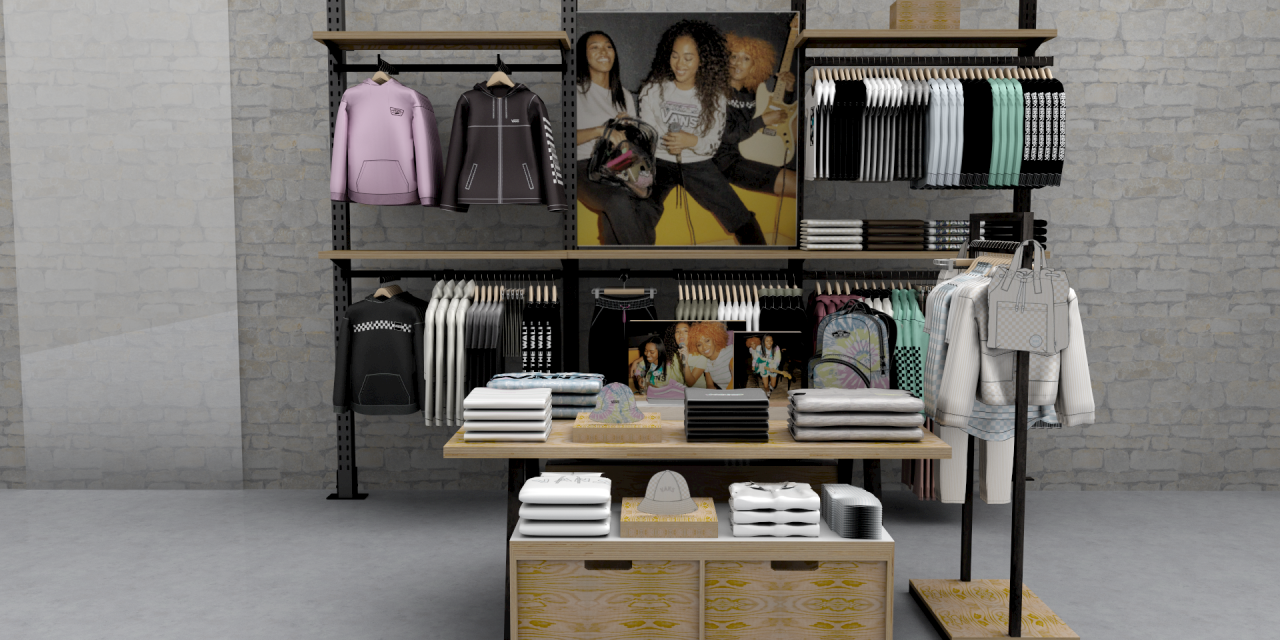‘We’ve eliminated two to three days of workload’: How Vans digitized its merchandising process

Over the last few years, Vans has drastically changed how it merchandizes the over 500 store floors its products are featured in — pivoting from an analog to digital process.
Skater and sneaker brand Vans — founded in 1966 and acquired by VF Corp in 2004 for $396 million — used to set its merchandising floor-sets physically. Each month, the brand would build out a demo store model highlighting which products to display and how to display them, photograph this model and send planning documents for in-store teams to execute it at their own stores.
Paul Rupert, visual merchandising manager for elevated retail at Vans, said that this process typically took five to six days of setting and an additional five to six days to photograph and document. When the pandemic first hit, however, store floor planning and store visits both became more complicated. In turn, Vans wanted to find a way to digitize both processes.
Vans turned to longterm partner and retail software company IWD to digitize floor concepts and simplify communication across stores and teams. Using IWD’s “Display” software, Vans now builds out virtual, 3D store renderings and has reduced the amount of time it takes to set up its floor refreshes by 25%. IWD’s “Network” software, meanwhile, has helped Vans’ in-store teams upload photos of their finalized stores and communicate with Vans’ executive team members virtually.
Rupert talked to Modern Retail about the complications of merchandising in a pandemic, Vans’ evolving store concepts and sharing merchandising knowledge across VF Corp’s broader brand portfolio. This interview has been edited for length and clarity.
How has digitizing your merchandising process sped up the workflow?
Before we fully embraced the full scope of capabilities within the Display program, we would set monthly floor-sets in our mock store. Physically setting all departments and store concepts would typically take around five to six days, with an additional five to six days to compile all assets and build out each floor-set document.
Since pivoting to using Display for the merchandising portion of our floor-set process, we’ve eliminated two to three days of workload, resulting in an average 25% workload reduction during our floor-set process. We have three store concepts that we really focus on in our floor-set document.
What are the three store concepts that you mentioned and how do they differ from one another?
Our first is our classic concept — our oldest store format. We have a second concept called “New Concept” that takes up the bulk of our retail fleets. And then a few years ago, we started opening our 3.0 concept stores. That is what we have deemed our go-forward store concept plan.
3.0 is much more of a modern look and feel; it is cleaner than our two previous concepts. It really places an emphasis on storytelling, marketing and connecting with the consumer in various different touchpoints.
Can you talk a bit about IWD’s Network feature? Why did you want to use a new communication platform to connect with associates?
As a visual merchandiser, I love getting a photo from a store. In these current realities where we’re not traveling as much, we’re doing fewer market visits. It’s been critical — now, more than ever — for us to have visibility into what our store environments look like. Network is the platform that I use with my field team to communicate all of these [merchandising] updates.
Since January of 2018, we’ve had over 23,000 photos added to the platform [by our store teams], and average roughly 150 uploads a week across eight store environments. This is instrumental in gaining visibility to what our retail environments look like throughout the month.
Vans falls under the VF Corp, parent to brands like North Face, Timberland and Dickies. Do any other brands in your portfolio use any of these features and is there any knowledge share in the merchandising space between Vans and sister brands?
Vans has been the pioneer of the IWD platform, though several of our sister brands have started to adopt the functionality of Display. I also know a few of our brands are looking into Network. [Now], there is a small, cross-functional relationship that we on the Vans’ side have with some of these sister brands. [Going forward], we’ve put a bigger focus on bringing our full corporation into the IWD partnership.

